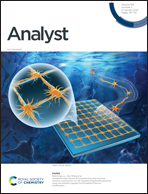A ferrocene-linked metal-covalent organic polymer as a peroxidase-enzyme mimic for dual channel detection of hydrogen peroxide†
Abstract
A novel ferrocene-linked metal-covalent organic polymer (MCOP-NFC) was synthesized through the Claisen–Schmidt condensation reaction of 1,1′-diacetyl ferrocene and tris(4-formylphenyl)amine. MCOP-NFC acts as a highly efficient artificial enzyme for mimicking peroxidase, and shows good stability in harsh chemical environments including strong bases and acids, and boiling water. Based on the peroxidase-like activity of MCOP-NFC, a highly sensitive dual channel detection method for hydrogen peroxide was developed. For the colorimetric detection strategy, the limit of detection (LOD) reached 2.1 μM, while the limit of detection was found to be as low as 0.08 μM based on the electrochemical detection channel. This study offers a new strategy for the development of an enzyme mimetic on the basis of the covalent assembly of nanostructures, and the proposed electrochemical–colorimetric sensor for H2O2 detection has great potential for applications in biology and biomedicine.



 Please wait while we load your content...
Please wait while we load your content...